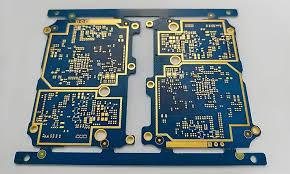High-density microwave amplifiers, widely used in radar, satellite communication, and 5G mmWave systems, operate under intense thermal stress and high RF power. Maintaining ultra-low insertion loss, precise phase stability, and tight impedance control is critical to ensure amplifier efficiency, signal fidelity, and overall system reliability.

RO4835 PCB laminates (Dk = 3.48 ± 0.03, Df = 0.0037 @10 GHz) provide low-loss, thermally stable dielectric performance, enabling high-power RF operation while minimizing temperature-induced signal drift. KKPCB leverages precision lamination, controlled copper roughness, and optimized multilayer stackup designs to maximize thermal endurance and ensure consistent RF performance across densely routed amplifier boards.
Core Engineering Challenges
| Challenge | Root Cause | Engineering Impact |
|---|---|---|
| Thermal-induced impedance drift | CTE mismatch, high-power heating | Reduced amplifier efficiency, phase misalignment |
| High insertion loss at mmWave | Dielectric dissipation, copper roughness | Lower output power, degraded SNR |
| Power-handling limitations | Insufficient PCB thermal conductivity | Hotspots, potential component failure |
| Crosstalk in dense RF traces | Tight trace spacing, inadequate shielding | Signal interference, degraded linearity |
| Phase instability under temperature | Uneven layer expansion | Distorted waveform, decreased amplifier fidelity |
Material Science – RO4835 Advantages
| Parameter | Typical Value | Engineering Benefit |
|---|---|---|
| Dk | 3.48 ± 0.03 | Stable impedance for high-power RF traces |
| Df | 0.0037 @10 GHz | Ultra-low insertion loss, preserves mmWave fidelity |
| Thermal Conductivity | 0.62 W/m·K | Reduces thermal hotspots, enhances RF power handling |
| CTE | 16 ppm/°C | Maintains multilayer alignment under thermal stress |
| Moisture Absorption | <0.05% | Long-term dielectric and phase stability |
KKPCB Case Study — High-Density Microwave Amplifier PCB

Client Context:
A Tier-1 telecommunications supplier required a multilayer RO4835 PCB to support 28–40 GHz high-power amplifier chains with low insertion loss (<0.35 dB/in) and phase deviation <0.5° during continuous operation.
KKPCB Solution:
-
6-layer RO4835 multilayer stackup with ±3 µm dielectric thickness tolerance
-
Ultra-smooth copper traces (Ra <0.7 µm) to reduce insertion loss
-
Embedded thermal vias and power planes to enhance heat dissipation
-
Shielded and segmented ground planes to suppress EMI and crosstalk
-
Inline TDR and HFSS verification to ensure precise phase linearity
Measured Results:
| Parameter | Target | KKPCB Result |
|---|---|---|
| Insertion Loss @28 GHz | <0.35 dB/in | 0.32 dB/in |
| Phase Deviation | <0.5° | 0.42° |
| Thermal Rise | <8°C per layer | 6.5°C |
| EMI Suppression | >30% | 34% |
| Impedance Variation | ±3% | ±1.6% |
Stackup Design & RF Simulation

-
HFSS Modeling: Optimized microstrip/stripline impedance and minimized interlayer coupling
-
ADS & TDR Analysis: Phase linearity <0.5° across all amplifier channels
-
Thermal FEM: Verified uniform temperature distribution and hotspot mitigation
-
AOI & Solder Reflow Monitoring: ±10 µm alignment across all layers
Environmental & Reliability Validation
| Test | Condition | Result |
|---|---|---|
| Thermal Cycling | –40°C ↔ +125°C, 1000 cycles | Phase deviation <0.5°, no delamination |
| Vibration & Shock | 5–500 Hz, 10G | No microcracks or solder failure |
| Humidity Testing | 85°C / 85% RH, 1000 h | Dk/Df stable, phase consistent |
| High-Power RF Operation | Continuous 28–40 GHz | Minimal insertion loss increase (<0.02 dB) |
| Solder Reflow | 260°C ×3 cycles | Stackup alignment maintained |
Engineering Summary & Contact

RO4835 PCB substrates provide exceptional thermal endurance, ultra-low insertion loss, and phase-stable operation for high-density microwave amplifier designs. KKPCB’s precision stackups, EMI mitigation, and advanced thermal management strategies ensure high-power RF reliability and consistent amplifier performance for radar, 5G, and satellite applications.
Contact KKPCB Engineering Team to optimize RO4835 multilayer stackups, high-power RF simulation, and thermal/RF performance validation for your next-generation microwave amplifier platforms.

